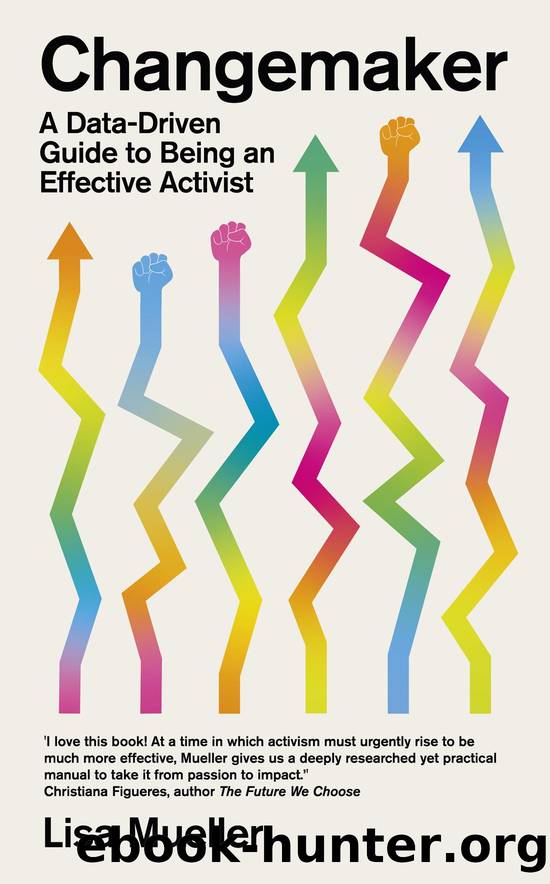Changemaker by Lisa Mueller

Author:Lisa Mueller
Language: eng
Format: epub
Publisher: Footnote Press Ltd
Published: 2024-07-29T00:00:00+00:00
MAKE YOUR COALITION MIND-FRIENDLY
Cognitive science shows us why the lack of a cohesive message turned out to be a fatal flaw for the Womenâs March coalition. Cohesive messages, which stick to the main point, are easier for our brains to comprehend than scrambled messages, which stray from the main point.42 Think back to the last time you read a poorly written article, where the paragraphs meandered away from topic sentences and ideas were haphazardly sprinkled throughout the text. It probably made your head hurt, especially if the article was on a subject that was unfamiliar to you. Your headache resulted from cohesion gaps, which occur when pieces of text have little overlap and force you to fill in the connections with your own knowledge.43 Research shows that cohesive texts are more persuasive than aimless texts because they are less taxing for the brain to process.44
Protests are a kind of text: powerholders âreadâ themâthrough signs, chants, apparel, and social media postsâand then decide whether to give protesters what they want. Powerholders canât grant demands that they canât understand. The Womenâs March, with its sundry stakeholders and grievances, was much less mind-friendly than the March for Life, with its unambiguous message. Republican politicians knew exactly what to do to appease their constituents: write state laws restricting abortion and seat judges who would overturn Roe v. Wade. Democratic politicians had no equivalent guidelines; their constituents were demanding the kitchen sink.
The divergent outcomes of the Womenâs March and the March for Life are consistent with the hypothesis that more cohesive demands make an activist coalition more likely to win concessions. However, itâs easy to cherry-pick cases to support a theory. After attending the Womenâs March and the March for Life, I wanted more conclusive evidence before advising readers to invest a ton of energy in uniting their coalitions around a central message. By âconclusive,â I mean a) generalizable and b) causal: Do cohesive demands correspond with better outcomes across many protests, not just the two I happened to attend in Washington? And if so, does crowd cohesion actually cause success, or just correlate with it? Conclusive studies didnât exist yet, so I became my own detective.45
To produce generalizable evidence, I compiled a database of ninety-seven protests in Europe and the Americas between 2009 and 2014. The protests were nominally about a host of issues, from climate change and gay pride to pensions and corruption. However, weâve seen that itâs difficult to tell what a protest is really about just by the protestâs name, especially when the event is orchestrated by a coalition of different groups. As we saw in Dana Fisherâs surveys, activists who attend a âgun controlâ rally or a âwomenâs marchâ might be there for all sorts of reasons. Luckily, a consortium of European researchers surveyed participants at each of these ninety-seven protests on why they had attended. I just needed to aggregate the responses into a measure of crowd cohesion. To do that, I used artificial intelligence that transformed raw survey responses (e.
Download
This site does not store any files on its server. We only index and link to content provided by other sites. Please contact the content providers to delete copyright contents if any and email us, we'll remove relevant links or contents immediately.
The Universe of Us by Lang Leav(15032)
The Sun and Her Flowers by Rupi Kaur(14471)
Adultolescence by Gabbie Hanna(8889)
Whiskey Words & a Shovel II by r.h. Sin(7981)
Love Her Wild by Atticus(7721)
Smoke & Mirrors by Michael Faudet(6153)
Wiseguy by Nicholas Pileggi(5711)
The Princess Saves Herself in This One by Amanda Lovelace(4933)
Love & Misadventure by Lang Leav(4816)
Memories by Lang Leav(4776)
Milk and Honey by Rupi Kaur(4714)
Bluets by Maggie Nelson(4515)
Too Much and Not the Mood by Durga Chew-Bose(4305)
Pillow Thoughts by Courtney Peppernell(4245)
Good morning to Goodnight by Eleni Kaur(4209)
The Poetry of Pablo Neruda by Pablo Neruda(4066)
Algedonic by r.h. Sin(4038)
HER II by Pierre Alex Jeanty(3583)
Stuff I've Been Feeling Lately by Alicia Cook(3419)
